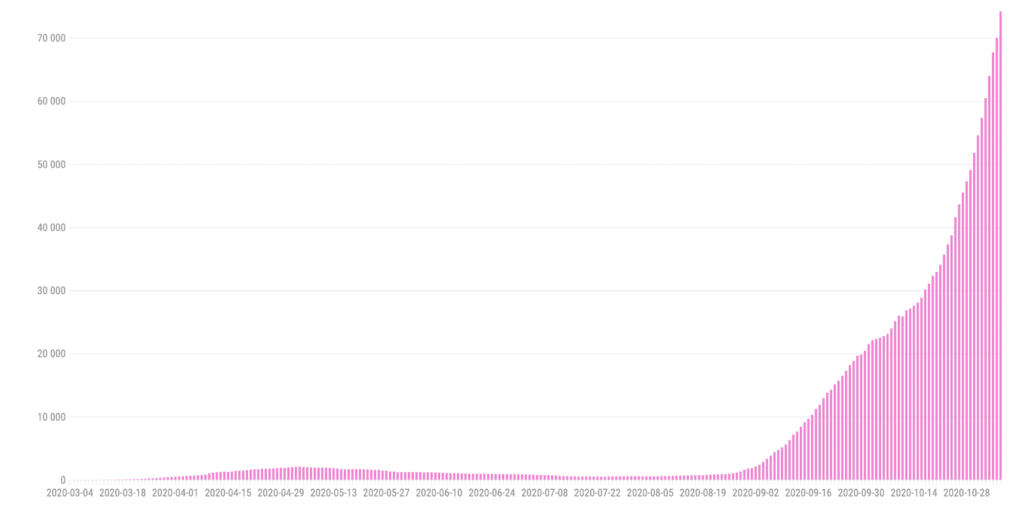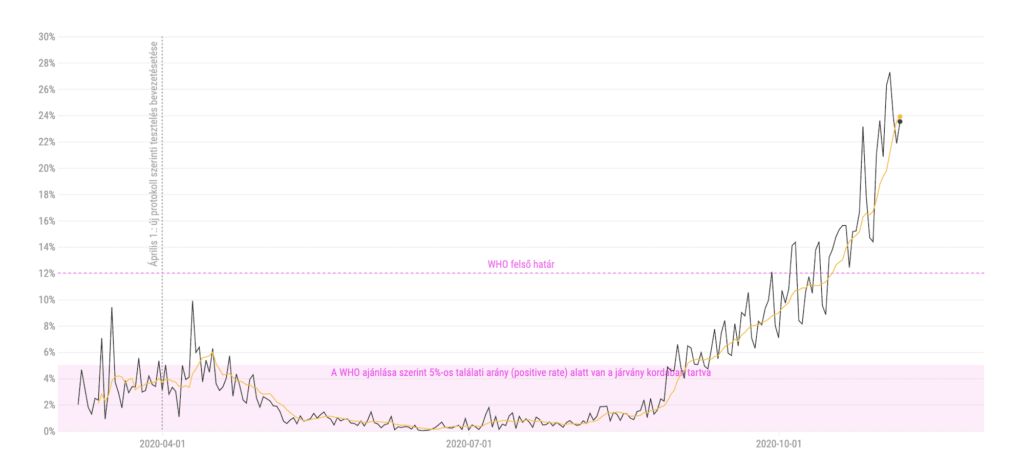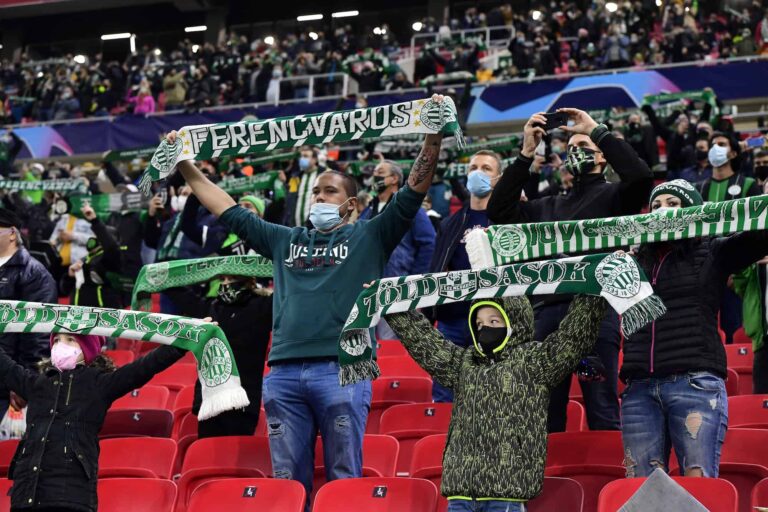Even though the government has been trying to stress for some time that they have prepared for the second wave of the pandemic, daily figures released in recent days appear to contradict this. While the number of infected people and new deaths are constantly growing, the number of tests and data regarding those who have recovered is now stagnating or even decreasing. Meanwhile, the government handles football matches with particular care – after all, it’s Prime Minister Viktor Orbán’s favorite sport.
by Szilvia Zsilák, Krisztián Szabó, Gabriella Horn (Atlatszo.hu)
The second wave of the coronavirus epidemic took hold in Hungary at the beginning of September, when the number of new infections began to increase by hundreds every day. A thousand people died within three weeks because of COVID-19 in October 2020 in Hungary. The official data for infected patients is around 60 thousand, but some experts believe, based on the high number of positive results in all tests, that in reality there may be as many as ten times more cases in the country.
Hungary seemed to be one of the few countries which successfully handled the first wave of the COVID-19 pandemic. Perhaps this contributed to a sense of over-confidence in the government: the summer came and went without any significant preparatory measures for the second wave. Until the end of October, only a few restrictions were introduced, despite the soaring figures of new infections and deaths. Football stadiums were still open to thousands of supporters on a regular basis. All the while, experts feared that the government’s determination to keep the economy going at all costs may result in tragedy and a collapse of the whole healthcare system in a few weeks.

Numbers of daily active cases in Hungary, source: https://atlo.team/koronamonitor/
More testing, home working, and remote education – these would be the key factors to avoiding a COVID-19 crisis in Hungary according to many experts in and outside the health sector. But it seems that the government ignored these warnings: even the most recent restrictions, introduced as of 4 November, are considered by many critics as only soft propaganda measures. One of the major issues is that schools are still open and are only allowed to operate online temporarily, though so far already seven teachers have died from coronavirus.
„We did what you asked for”
A hospital in the city of Miskolc, caring for COVID-19 patients in Northeast Hungary, was recently reported to be completely full up – though the worst scenario of a second wave, predicted and feared by many, has not yet fully occurred across the country. Many hospitals are already struggling with a critical shortage of staff. As a result of inadequate healthcare policies, thousands of employees have since left the country or the healthcare profession to be able to make a decent living. The government has now announced some last minute measures and pay rises but these were done without consulting the trade unions and professional organizations. As a result, the measures announced have drawn wide criticism from those working in the health sector.
The government – not having done anything significant through the summer to prepare for the second wave – has tried to transfer some of the responsibility for their decisions onto critics and onto Hungarian citizens themselves, claiming that the introduced measures are in accordance with the results of the „national consultation” on the coronavirus epidemic. These were questionnaires with weighted questions, sent out in the summer across the country.
However, many believe this was nothing but another one of the government’s propaganda exercises, which can be used later to justify certain government decisions, with the government able to claim that they were acting in accordance with the Hungarian people.
Viktor Orbán has been making sure that if things should go wrong – and some predictions say this may well happen – he is not the one to blame. The Prime Minister recently gave a speech in which he said that whoever criticizes the government’s measures actually goes against the expert opinion of their trusted advisors, technically meaning they are instead to blame.
However, it appears some of these experts realised the Prime Minister’s statement amounted to a transferring of the responsibility away from the government: and many have now openly expressed their concern and criticism of the country’s strategy in handling the pandemic. In fact, according to many health sector employees, the government does not really listen to these expert opinions anyway.
Clandestine data
The Hungarian government was not very successful – to say the least – at publishing data during the first wave of the pandemic. Journalists faced real difficulties in trying to get information from the “Operational Body” in charge of handling the pandemic. It seems that the situation has not improved much in terms of transparency now the country enters the second wave. The Medical Chamber is now preparing an online and public interface where doctors and nurses will be able to present the facts about the situation within the health sector. Their aim is to publicise the real conditions and figures in hospitals and surgeries. These figures so far have mostly surfaced only through social media channels, thanks to brave and desperate healthcare workers.
The Hungarian government publishes daily data about the spread of coronavirus in the country on a dedicated website, koronavirus.gov.hu, every morning from 8 to 10 a.m. Every update contains the number of new, total and active infections, the total number of deaths and of recovered cases, the total number of hospitalized patients and those on ventilators, the percentage distribution of COVID-19 positive patients, and the number of deaths and recovered cases in the capital and in the countryside. These posts also describe current regulations, standards, and new measures. Because all this is presented only in text form, it is time-consuming to extract any relevant data from it, without the possibility to look at figures displayed in a table, or against the previous day’s numbers.
The data on the number of infections per county are published on a separate, image-only map in poor quality which is replaced on a daily basis, so older maps simply disappear from the website. Even so, the current way of publishing data is significantly better than during the first wave of the pandemic in the spring.
Slow reaction
During the relatively quiet summer period of the pandemic, many protective measures were relaxed. Restrictions on foreign travel, quarantine obligations, curfews, and mask-wearing regulations were suspended. And nothing was done to prepare the country for the second wave of the pandemic. Even when the number of new infections per day rose well above the peak of the first wave at the end of August, it was not followed by the immediate reintroduction of restrictions. Eventually, on September 1, the borders were closed, meaning anyone entering the country would be obliged to go into quarantine for 14 days (this was later modified to 10 days). But to maintain the “operability of the country” no curfew was imposed.
PM Orbán: Hungary must continue to function – Read more on the blog here: https://t.co/uT9DSzij10 pic.twitter.com/qADsNMcP48
— About Hungary (@abouthungary) September 11, 2020
The most important element of protective measures is the wearing of masks, but even this was made compulsory in only gradual stages. At the beginning of the second wave, it was only obligatory to wear a mask in shops and on public transportation, a policy which was then extended to additional circumstances.
In the first wave, the introduction of the curfew was followed by schools switching to online education. Although a curfew between 12 p.m. and 6 a.m. was introduced as of 4 November 2020, schools and kindergartens are still open. Educational institutions are only closed temporarily if positive cases are found there. The temperature of students and staff are checked at the entrance, and anyone with a temperature above 37,6 degrees Celsius is sent home. Many experts, teacher organizations, and opposition politicians are stressing the need for the introduction of online teaching, highlighting the fact that young people often do not display any symptoms when infected with COVID-19.
Testing, testing, testing
At the beginning of September, the number of tests performed daily increased considerably, averaging at 10,000. However, this did not increase in parallel with the number of daily cases, and in fact, even after performing more tests by the end of October, it was nowhere near enough to provide reliable information on the spreading of the virus.

The proportion of new positive tests within new tests, source: https://atlo.team/koronamonitor/
The WHO has set an upper limit of 12 percent of samples positive for COVID-19, above which testing is not considered representative – and controlling the epidemic becomes increasingly difficult. Hungary reached this limit in the middle of October, with figures now increasing beyond that point. Determining the true rate of the spread of the virus in Hungary at this stage would require the whole population to be tested, as was recently introduced in Slovakia.
One of the highly emphasized actions of the Hungarian government during the first wave was the purchase of a large number of ventilators. But even now, with several times as many people needing assisted ventilation as in the first wave, the number of devices used is well below the amount purchased by the government. As a result, the government is trying to sell or give away excess machinery.
In fact, some of the public purchases related to the pandemic display telltale signs of Viktor Orbán’s illiberal regime which – according to many – is famous for corrupt or questionable public deals. Atlatszo.hu has covered a number of such contracts, among others, the case of János Hiszem, a key Hungarian figure connected to the Azerbaijani Laundromat scandal, who is one of the big beneficiaries of the epidemic business: his company supplies € 79 million worth of ventilators and other medical equipment under a contract with the Ministry of Foreign Affairs and Trade of Hungary.
Privileged football
Prime Minister Viktor Orbán’s favorite sport is football, so it is not surprising that the Hungarian government handles football matches with particular care during the epidemic. The presidency of the Hungarian Football Association lifted the restrictions and security measures concerning domestic football matches as early as on June 18. However, the biggest outrage was caused by the fact that the match for the UEFA Super Cup final was held in front of spectators on September 24 at the Puskás Arena in Budapest. According to the regulations, instead of 67,000 people, only 30 percent of fans could watch the match on the spot – but that still meant a potential of 20,000 people could amass at the stadium.
The match between Bayern Munich and Seville in Budapest was the first international match since the first wave to not be held behind closed doors but in front of spectators. Several musicians criticized the holding of this event, as music and dance events with more than 500 people were not allowed at the time due to the pandemic.
Despite the threat of an epidemic, in late September “Fradi” (nickname for Ferencváros TC football club) supporters – without masks – gathered in front of the Groupama Arena, as the match against Dinamo Zagreb was a closed event. The national league (NB I) matches were attended by greater crowds than the Super Cup and the fans often did not keep to social distancing, or wear masks.
More tightened restrictions were introduced from October 23, with the use of medical masks being made mandatory at outdoor events such as football matches for all spectators, except for children under the age of six. The new, stricter government regulations introduced from November 4 require social distancing of one and a half meters between spectators (even in cafeterias) at domestic sporting events, with only every third seat available to be used. The organizers are responsible for complying with the regulations, and they have to exclude visitors who do not follow the rules.
Compliance with the regulations is monitored by the police, and in case of violation, the authority may impose a fine of HUF 100,000 -1 million or may close the location for a maximum of one week. Exempt from this rule are stadiums and sports halls, which cannot be closed – but a maximum of ten “closed” matches can be ordered in their case as punishment.
At international events – such as the popular Champions League matches of Ferencváros or the qualifying round of the Hungarian national team against Iceland – the restrictions do not apply, with only mandatory mask wearing in force. The regulations of the international federation also have to be observed.
Hungary is now following the Visegrad countries most affected by the pandemic like Czech and Poland. The scale of the defeat in this game is being measured by the real number of deaths. The first forward doesn’t seem prepared for the second half of this match.
She has been working as a journalist and news editor for over 20 years now, at News Network Ltd., RTL Klub television and a number of national print publications. Freelancing for atlatszo.hu from the beginning, she joined full time in 2019. Based in Budapest, Hungary.






